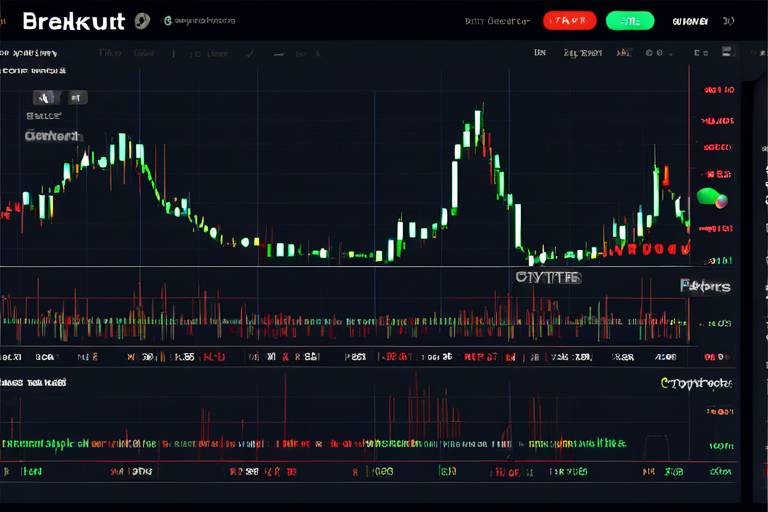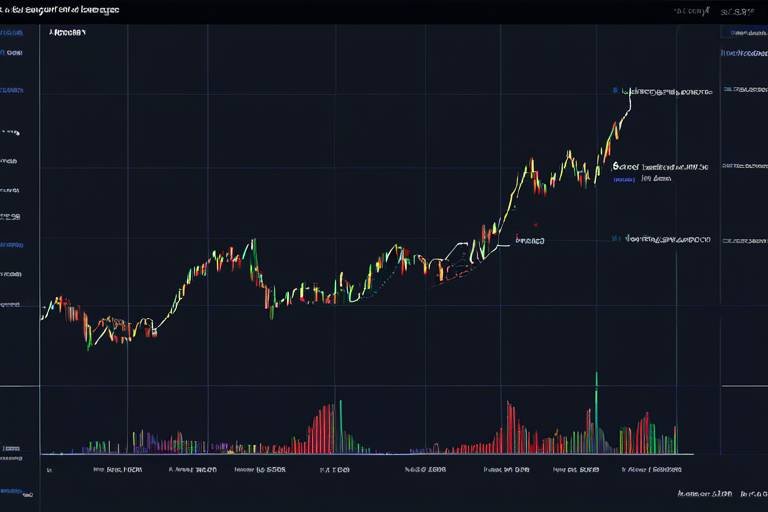The Role of Arbitrage in Cryptocurrency Trading
Arbitrage in cryptocurrency trading is like finding hidden treasure in a vast ocean of digital assets. It’s a strategy that savvy traders use to capitalize on price differences for the same asset across various exchanges. Imagine you’re at a bustling market where the same fruit is sold at different prices. If you buy low in one stall and sell high in another, you pocket the difference. This principle applies to cryptocurrencies, where the market is notoriously volatile and prices can vary significantly between platforms. Understanding how arbitrage works is vital for anyone looking to navigate the complex world of cryptocurrency trading.
In essence, arbitrage is the practice of exploiting price discrepancies in different markets to make a profit. It’s not just limited to cryptocurrencies; traditional finance has long benefited from this strategy. However, the rapid pace and unique characteristics of the crypto market make it especially ripe for arbitrage opportunities. The decentralized nature of cryptocurrencies means that prices can fluctuate wildly based on supply and demand dynamics, trading volumes, and even the time of day. This volatility creates a fertile ground for arbitrageurs who are quick to act.
But why is arbitrage so significant? Well, it serves several crucial functions in the cryptocurrency ecosystem. First, it enhances market efficiency. When traders engage in arbitrage, they help align prices across different exchanges, reducing discrepancies and promoting a fairer market. Imagine a scale balancing out weights; arbitrage acts as the force that levels the playing field. Additionally, it increases liquidity in the market, making it easier for other traders to buy and sell assets without causing drastic price changes.
As we dive deeper into the mechanics of arbitrage, it’s essential to understand the various strategies that traders employ. From spatial arbitrage to triangular arbitrage, each method has its unique advantages and challenges. The next sections will explore these strategies in detail, providing insights into how traders can effectively harness the power of arbitrage in their trading endeavors.
Arbitrage involves exploiting price differences of the same asset across different markets. This section will delve into its definition, types, and how it applies specifically to cryptocurrencies.
There are various arbitrage strategies used in cryptocurrency trading. This section will outline the most common types, including spatial, temporal, and triangular arbitrage, and their respective advantages.
Spatial arbitrage refers to buying a cryptocurrency at a lower price on one exchange and selling it at a higher price on another. This subsection explains how traders can capitalize on price discrepancies.
To successfully engage in spatial arbitrage, traders must constantly monitor multiple exchanges. This part discusses tools and techniques for identifying profitable opportunities in real-time.
While spatial arbitrage can be profitable, it also comes with challenges such as transaction fees and withdrawal limits. This subsection highlights these obstacles and potential solutions.
Triangular arbitrage involves trading between three different currencies to exploit price discrepancies. This section will explain the mechanics and benefits of this strategy in cryptocurrency trading.
Despite its potential for profit, arbitrage trading in cryptocurrencies carries risks. This section will examine market volatility, execution risk, and regulatory concerns that traders should be aware of.
Arbitrage plays a crucial role in enhancing market efficiency. This section discusses how arbitrage activities help align prices across exchanges, reducing discrepancies and promoting fair value.
As the cryptocurrency market evolves, so does the landscape for arbitrage trading. This section will explore emerging trends, technological advancements, and the potential future of arbitrage strategies in this dynamic market.
- What is arbitrage in cryptocurrency? Arbitrage in cryptocurrency refers to the practice of buying a digital asset at a lower price on one exchange and selling it at a higher price on another.
- Is arbitrage trading risky? Yes, while arbitrage trading can be profitable, it carries risks such as market volatility, execution risk, and regulatory concerns.
- What are the types of arbitrage strategies? The main types of arbitrage strategies include spatial arbitrage, temporal arbitrage, and triangular arbitrage.
- How does arbitrage improve market efficiency? Arbitrage helps align prices across different exchanges, reducing discrepancies and promoting a fair market.

Understanding Arbitrage
Arbitrage is a fascinating concept that thrives on the principle of exploiting price differences of the same asset across various markets. Imagine being at a bustling marketplace where you can buy apples for a dollar at one stall and sell them for two dollars at another just a few steps away. This is essentially what arbitrage is all about, but in the world of finance and, more specifically, cryptocurrency trading. The beauty of arbitrage lies in its ability to create opportunities for traders to profit by capitalizing on these discrepancies in pricing. It’s like a treasure hunt, where the treasure is the difference in price, and the hunt is all about timing and market awareness.
In the realm of cryptocurrencies, arbitrage can take on several forms. The most common types include spatial arbitrage, temporal arbitrage, and triangular arbitrage. Each type has its unique mechanisms and strategies, allowing traders to navigate the complex waters of the crypto market effectively. The essence of arbitrage is rooted in the inefficiencies that exist in the market. Due to the decentralized nature of cryptocurrencies, prices can vary significantly across different exchanges. This discrepancy creates a window of opportunity for savvy traders who are quick on their feet and equipped with the right tools.
To put it simply, arbitrage is not just a strategy; it’s a game of speed and precision. Traders must be constantly vigilant, monitoring price movements across multiple exchanges to identify the best opportunities. The rapid fluctuations in the cryptocurrency market mean that what might be a profitable trade one moment could evaporate in the next. This urgency adds an exhilarating layer to arbitrage trading, making it both exciting and highly competitive.
In summary, understanding arbitrage in cryptocurrency trading is about recognizing the potential to make profits by taking advantage of price differences across various platforms. It requires a keen eye for detail, a solid grasp of market dynamics, and the ability to act swiftly. As we delve deeper into the different types of arbitrage strategies, we’ll uncover how traders can effectively utilize these opportunities to enhance their trading success.

Types of Arbitrage Strategies
When diving into the world of cryptocurrency trading, understanding the various arbitrage strategies is essential for any trader looking to capitalize on market inefficiencies. These strategies are not just theoretical concepts; they are practical methods that can lead to significant profits if executed correctly. Let’s explore the most common types of arbitrage strategies that traders often employ.
The first type is spatial arbitrage, which involves buying a cryptocurrency at a lower price on one exchange and selling it at a higher price on another. Imagine you find Bitcoin selling for $30,000 on Exchange A and $30,500 on Exchange B. By purchasing on A and selling on B, you pocket the difference. This strategy is relatively straightforward but requires constant monitoring of multiple exchanges to identify these price discrepancies.
Next, we have temporal arbitrage. This strategy focuses on taking advantage of price changes over time rather than across different exchanges. For instance, if you anticipate that the price of Ethereum will rise due to upcoming market news, you might buy it now and sell it later when the price increases. Temporal arbitrage relies heavily on market analysis and forecasting, making it a bit more complex than spatial arbitrage.
Another fascinating approach is triangular arbitrage. This strategy involves trading between three different currencies on the same exchange to exploit price discrepancies. For example, if you notice that the exchange rates between Bitcoin, Ethereum, and Litecoin are misaligned, you could trade Bitcoin for Ethereum, then Ethereum for Litecoin, and finally Litecoin back to Bitcoin, all while making a profit from the differences in exchange rates. It’s like a dance among currencies, requiring quick execution and a deep understanding of market dynamics.
Each of these strategies has its own advantages and disadvantages. Spatial arbitrage is often seen as the most accessible, especially for beginners, while triangular arbitrage can be more profitable but requires more expertise and speed. Temporal arbitrage, on the other hand, is heavily reliant on market knowledge and timing. Traders must weigh these factors when choosing which strategy to implement.
In conclusion, understanding these arbitrage strategies is crucial for anyone looking to navigate the complex world of cryptocurrency trading. Each strategy offers unique opportunities and challenges, making it essential for traders to stay informed and adaptable in this ever-changing market.
As we continue this journey into the world of arbitrage, let’s not forget the importance of staying updated on market trends and technological advancements, as these can significantly influence the effectiveness of these strategies.

Spatial Arbitrage
Spatial arbitrage is a fascinating concept in the realm of cryptocurrency trading, and it essentially revolves around the idea of taking advantage of price differences for the same cryptocurrency across various exchanges. Imagine walking into two different stores that sell the same product, but one store has a sale while the other does not. This is the core principle of spatial arbitrage—buy low in one place and sell high in another. In the world of cryptocurrencies, this can translate to significant profits if executed correctly. Traders who are quick on their feet and have access to multiple exchanges can capitalize on these discrepancies, turning what might seem like small differences into substantial gains.
To effectively engage in spatial arbitrage, traders must be vigilant and possess a keen understanding of market dynamics. They need to monitor multiple exchanges continuously, as prices can fluctuate rapidly. For instance, if Bitcoin is trading at $30,000 on Exchange A and $30,500 on Exchange B, a savvy trader can buy Bitcoin on Exchange A and sell it on Exchange B, pocketing a profit of $500 per Bitcoin, minus any transaction fees. However, this strategy isn't without its challenges. Traders must also consider factors such as transaction fees, which can eat into profits, and withdrawal limits that might prevent them from moving their assets quickly enough to capitalize on price differences.
Identifying opportunities for spatial arbitrage requires the right set of tools and techniques. Traders often use specialized software or trading bots that can monitor price movements across multiple exchanges in real-time. These tools can alert traders to potential arbitrage opportunities, allowing them to act swiftly before the market corrects itself. Additionally, some traders utilize APIs provided by exchanges to automate their trading strategies, making the process faster and more efficient. However, it's crucial to remember that the cryptocurrency market is notoriously volatile, and what appears to be a profitable opportunity can vanish in the blink of an eye.
While spatial arbitrage can be a lucrative strategy, it does come with its share of challenges. For example, if a trader buys a cryptocurrency on one exchange but faces delays in transferring it to another exchange for selling, the price might change, negating potential profits. Furthermore, regulatory issues can complicate matters, as some exchanges may have restrictions on withdrawals or trading limits that can hinder a trader's ability to execute their strategy effectively. Thus, while the allure of quick profits through spatial arbitrage is enticing, it requires careful planning and execution to navigate the inherent risks.
In conclusion, spatial arbitrage presents an exciting opportunity for cryptocurrency traders willing to put in the effort to monitor markets and act quickly. By understanding the mechanics of price discrepancies and employing the right tools, traders can unlock the potential for substantial profits. However, they must remain vigilant and aware of the challenges that come with this strategy, ensuring they are well-prepared to adapt to the fast-paced world of cryptocurrency trading.

Identifying Opportunities
Identifying opportunities in spatial arbitrage is akin to being a treasure hunter, where the treasure is the price discrepancy of cryptocurrencies across various exchanges. To successfully capitalize on these discrepancies, traders need to be equipped with the right tools and strategies. The first step in this journey is to constantly monitor multiple exchanges. This means being on the lookout for price variations that can arise due to differences in supply and demand, trading volume, and even market sentiment.
One effective method to track these opportunities is through the use of arbitrage bots. These automated trading systems can scan multiple exchanges simultaneously, alerting traders about profitable trades in real-time. Imagine having a personal assistant who never sleeps, tirelessly searching for the best deals while you focus on other aspects of your trading strategy. However, while these bots are incredibly useful, they require careful setup and constant monitoring to ensure they are functioning correctly and making the right trades.
Another approach is to utilize price alert tools provided by many trading platforms. These tools allow traders to set specific price points for cryptocurrencies, notifying them when the price reaches a predetermined level on different exchanges. This feature is particularly valuable in a market that can change in the blink of an eye. By receiving instant alerts, traders can make quick decisions and execute trades before the opportunity vanishes.
Additionally, traders should be aware of the trading volume and liquidity of the exchanges they are monitoring. Higher trading volume often indicates a more stable market, which can lead to fewer price discrepancies. Conversely, low liquidity can result in larger price swings, creating more opportunities for arbitrage but also increasing risk. Therefore, understanding the dynamics of each exchange is crucial for successful arbitrage trading.
To illustrate this further, consider a simple comparison of two exchanges, Exchange A and Exchange B, for the cryptocurrency Bitcoin (BTC):
| Exchange | Price of BTC | Trading Volume |
|---|---|---|
| Exchange A | $30,000 | 1,000 BTC |
| Exchange B | $30,500 | 500 BTC |
In this scenario, a trader can buy BTC from Exchange A at $30,000 and sell it on Exchange B for $30,500, pocketing a profit of $500 per BTC. However, to maximize profits, the trader must consider transaction fees, withdrawal limits, and the time it takes to transfer funds between exchanges.
Ultimately, identifying opportunities in spatial arbitrage requires a combination of vigilance, the right tools, and a deep understanding of the market dynamics at play. By leveraging technology and staying informed, traders can turn price discrepancies into profitable trades, navigating the exciting world of cryptocurrency with confidence.

Challenges in Spatial Arbitrage
While spatial arbitrage presents a lucrative opportunity for traders looking to capitalize on price discrepancies across different exchanges, it is not without its challenges. One of the primary obstacles is the transaction fees associated with buying and selling cryptocurrencies. These fees can significantly eat into profits, especially when the price difference between exchanges is minimal. For instance, if you buy Bitcoin at $40,000 on Exchange A and sell it for $40,100 on Exchange B, but the transaction fees amount to $100, your profit evaporates. Therefore, it becomes crucial for traders to factor in these costs when calculating potential gains.
Another challenge is the withdrawal limits imposed by many exchanges. Some platforms may restrict the amount of cryptocurrency you can withdraw within a specific timeframe, which can hinder your ability to execute trades swiftly. Imagine you spot a fantastic arbitrage opportunity, but the exchange limits your withdrawal to 0.5 BTC daily, while you need to trade 1 BTC to take full advantage of the price difference. This limitation can prevent you from fully capitalizing on market inefficiencies.
Moreover, market volatility can turn a seemingly profitable trade into a loss in the blink of an eye. Cryptocurrency prices can fluctuate wildly within minutes, and if a trader is not quick enough to execute their trades, they may find that the price difference has vanished by the time they complete their transactions. This risk is exacerbated during periods of high market activity, where rapid price changes can occur.
To navigate these challenges, traders often employ various tools and strategies. For example, using automated trading bots can help execute trades faster than manual trading, reducing the impact of market volatility. Additionally, some traders choose to focus on fewer exchanges to minimize the complexity of monitoring multiple platforms, allowing them to react more swiftly to price changes.
In summary, while spatial arbitrage offers enticing profit opportunities, traders must remain vigilant and aware of the inherent challenges. By understanding and preparing for transaction fees, withdrawal limits, and market volatility, they can enhance their chances of success in this fast-paced trading environment.
- What is spatial arbitrage? Spatial arbitrage is the practice of buying a cryptocurrency at a lower price on one exchange and selling it at a higher price on another.
- What are the main challenges of spatial arbitrage? The main challenges include transaction fees, withdrawal limits, and market volatility.
- How can I mitigate risks associated with spatial arbitrage? Traders can mitigate risks by using automated trading tools, limiting the number of exchanges monitored, and carefully calculating potential profits after fees.
- Is spatial arbitrage profitable? Yes, it can be profitable, but it requires careful monitoring and quick execution to capitalize on price discrepancies.

Triangular Arbitrage
Triangular arbitrage is a fascinating strategy that allows traders to exploit discrepancies in currency prices across three different markets. Imagine you have three currencies: Bitcoin (BTC), Ethereum (ETH), and Litecoin (LTC). If you notice that the exchange rates between these currencies aren’t aligned, there’s an opportunity for profit! This strategy is particularly powerful in the fast-paced world of cryptocurrency, where prices can fluctuate wildly within seconds.
The mechanics of triangular arbitrage are relatively straightforward. First, you start with one currency, say BTC. You then exchange it for ETH on one exchange where the rate is favorable. Next, you take that ETH and trade it for LTC on another exchange. Finally, you convert the LTC back into BTC. If done correctly, you should end up with more BTC than you started with, capitalizing on the price differences that existed in the market.
To illustrate this, let’s look at a hypothetical scenario:
| Currency Pair | Exchange Rate |
|---|---|
| BTC to ETH | 0.05 |
| ETH to LTC | 3 |
| LTC to BTC | 0.02 |
In this example, if you start with 1 BTC, you would convert it to 20 ETH (1 BTC / 0.05 ETH/BTC), then convert those 20 ETH to 60 LTC (20 ETH * 3 LTC/ETH), and finally convert the 60 LTC back to 1.2 BTC (60 LTC * 0.02 BTC/LTC). Voila! You’ve made a profit of 0.2 BTC just by taking advantage of the price inconsistencies!
However, while the concept might sound simple, executing triangular arbitrage can be quite complex and requires a keen sense of timing and access to real-time data. Traders need to be aware of transaction fees that may eat into their profits. Additionally, speed is of the essence; in the world of crypto, opportunities can vanish in the blink of an eye. As such, many traders use automated trading bots to execute these strategies efficiently.
In conclusion, triangular arbitrage is an exciting and potentially lucrative strategy for savvy traders. It not only requires a solid understanding of market dynamics but also the ability to act quickly and decisively. If you’re looking to enhance your trading game, mastering triangular arbitrage could be a game changer!
- What is triangular arbitrage? Triangular arbitrage is a trading strategy that involves exchanging one currency for another through a third currency to exploit price discrepancies across different markets.
- How does triangular arbitrage work? Traders convert an initial currency into a second currency, then into a third, and finally back into the original currency, ideally ending up with more than they started with.
- What are the risks associated with triangular arbitrage? Risks include market volatility, transaction fees, and the speed at which trades must be executed to realize profits.
- Can anyone engage in triangular arbitrage? Yes, but successful execution typically requires access to multiple exchanges, real-time data, and sometimes automated trading tools.

Risks of Arbitrage Trading
While arbitrage trading in cryptocurrencies can be an exciting way to capitalize on price discrepancies, it is not without its risks. Understanding these risks is crucial for any trader looking to navigate this volatile market. One of the primary concerns is market volatility. The cryptocurrency market is notorious for its rapid price fluctuations, which can occur within minutes. A trader might spot an arbitrage opportunity, but by the time they execute their trades, the price difference may have vanished, leading to potential losses instead of profits.
Another significant risk is execution risk. This refers to the possibility that a trader may not be able to execute their trades at the desired price due to slippage or delays in transaction processing. In the fast-paced world of cryptocurrency trading, even a few seconds can make a huge difference. For instance, if a trader is trying to buy a coin on one exchange while simultaneously selling it on another, any delay in executing either transaction can lead to a situation where the expected arbitrage profit turns into a loss.
Additionally, transaction fees can eat into profits significantly. Each trade typically incurs fees, whether it's a flat fee or a percentage of the transaction value. If the price difference between exchanges is minimal, high transaction fees can turn a seemingly profitable trade into a losing one. Traders must account for these costs when calculating potential profits from arbitrage opportunities.
Moreover, withdrawal limits imposed by exchanges can pose another challenge. Many exchanges set limits on how much cryptocurrency or fiat currency can be withdrawn within a certain timeframe. This can hinder a trader's ability to capitalize on arbitrage opportunities, especially if they need to quickly move funds between exchanges. For example, if an arbitrage opportunity arises but the trader can only withdraw a limited amount from one exchange, they may miss out on the chance to profit.
Lastly, regulatory concerns cannot be overlooked. The legal landscape surrounding cryptocurrencies is still developing, and regulations can vary significantly from one jurisdiction to another. Changes in regulations can impact the ability to trade on certain exchanges or impose new compliance requirements. Traders must stay informed about the regulatory environment to avoid potential legal pitfalls.
In summary, while arbitrage trading can offer lucrative opportunities, it is essential for traders to be aware of the inherent risks. By understanding factors such as market volatility, execution risk, transaction fees, withdrawal limits, and regulatory concerns, traders can better prepare themselves to navigate the complexities of the cryptocurrency market.
- What is arbitrage in cryptocurrency trading? Arbitrage involves buying a cryptocurrency on one exchange at a lower price and selling it on another exchange at a higher price, capitalizing on the price difference.
- Is arbitrage trading safe? While it can be profitable, arbitrage trading carries risks such as market volatility, execution risk, and regulatory concerns. Traders should be well-informed before engaging in it.
- How can I minimize risks in arbitrage trading? To minimize risks, traders should monitor multiple exchanges, account for transaction fees, and stay updated on regulatory changes that may affect trading.

Impact on Market Efficiency
Arbitrage plays a crucial role in enhancing market efficiency, particularly in the fast-paced world of cryptocurrency trading. When traders engage in arbitrage, they are essentially acting as market makers, helping to align prices across different exchanges. This alignment is vital because it minimizes price discrepancies that can lead to market inefficiencies. Think of it like a well-tuned orchestra; when one instrument is out of sync, the entire performance suffers. Similarly, when prices of the same asset vary significantly across platforms, it creates opportunities for traders to exploit these differences, which can disrupt the overall market harmony.
Moreover, the activities of arbitrageurs contribute to the liquidity of the market. By buying low on one exchange and selling high on another, they increase the volume of trades, making it easier for other traders to buy and sell cryptocurrencies without causing significant price fluctuations. This increased liquidity is essential for the stability of the market. When liquidity is high, it means that there are enough buyers and sellers to facilitate transactions smoothly, which ultimately leads to more accurate pricing.
To illustrate this impact, let’s consider a simple example. Imagine two exchanges, Exchange A and Exchange B, where Bitcoin is priced at $40,000 on Exchange A and $40,500 on Exchange B. An arbitrageur can buy Bitcoin from Exchange A and sell it on Exchange B, pocketing a profit of $500 per Bitcoin. As more traders exploit this price difference, the demand on Exchange A will increase, causing the price to rise, while the supply on Exchange B will increase, causing the price to fall. This interaction helps to bring the prices closer together, demonstrating how arbitrage contributes to market efficiency.
Furthermore, the presence of arbitrage opportunities can act as a signal for traders and investors. If they notice persistent price discrepancies, it may indicate that the market is not functioning optimally, potentially leading to further analysis and trading strategies aimed at correcting these inefficiencies. This self-correcting mechanism is vital for the long-term health of the cryptocurrency market.
In conclusion, the impact of arbitrage on market efficiency cannot be overstated. By facilitating price alignment and enhancing liquidity, arbitrageurs not only benefit themselves but also contribute to a more robust and fair trading environment for all participants. As the cryptocurrency market continues to evolve, the role of arbitrage will likely become even more significant, highlighting the interconnectedness of different exchanges and the importance of maintaining market integrity.
- What is arbitrage in cryptocurrency trading?
Arbitrage in cryptocurrency trading refers to the practice of buying a cryptocurrency at a lower price on one exchange and selling it at a higher price on another to profit from the price difference.
- How does arbitrage improve market efficiency?
Arbitrage improves market efficiency by minimizing price discrepancies across exchanges, which helps to align prices and increase liquidity in the market.
- What are the risks associated with arbitrage trading?
Risks of arbitrage trading include market volatility, execution risk, and potential regulatory concerns that traders need to be aware of.
- Can anyone engage in arbitrage trading?
Yes, anyone with access to cryptocurrency exchanges and the necessary tools can engage in arbitrage trading, although it requires knowledge and quick decision-making skills.

Future of Arbitrage in Cryptocurrency
The future of arbitrage in cryptocurrency trading is poised for significant evolution as the market matures and technology advances. With the rapid growth of decentralized finance (DeFi) and the increasing number of exchanges, traders are presented with a plethora of opportunities to exploit price discrepancies. But what does this mean for the average investor? Well, it opens up a world of possibilities, making it easier than ever to engage in arbitrage trading.
One of the most exciting trends is the rise of automated trading bots. These bots can analyze multiple exchanges simultaneously, executing trades at lightning speed. Imagine having a personal assistant that never sleeps, constantly on the lookout for price differences, ready to pounce at the right moment. This technology not only increases the efficiency of arbitrage but also reduces the emotional stress that can come with manual trading. However, it’s essential to stay informed about the risks associated with relying on automated systems, as market conditions can change rapidly.
Furthermore, the integration of artificial intelligence (AI) in trading strategies is another game-changer. AI can process vast amounts of data to identify patterns and predict price movements, allowing traders to make more informed decisions. As AI continues to evolve, we can expect more sophisticated algorithms that enhance arbitrage strategies. Just think about it: trading based on real-time data analysis instead of gut feelings—sounds appealing, right?
Moreover, as regulatory frameworks around cryptocurrencies become clearer, we can anticipate a more stable environment for arbitrage trading. Regulations can help reduce the risks associated with fraud and market manipulation, thus attracting more institutional investors. This influx of capital can lead to increased market liquidity, making it easier for traders to execute arbitrage strategies without significantly impacting prices.
In addition, the growth of cross-border trading platforms will further facilitate arbitrage opportunities. Traders will be able to access a wider range of markets, increasing the potential for price discrepancies. With the world becoming more interconnected, the barriers to entry for new traders are lowering, creating a more competitive landscape. However, this also means that seasoned traders will need to stay sharp and continuously adapt their strategies to maintain an edge.
As we look ahead, we should also consider the potential challenges that may arise. For instance, the increased competition could lead to narrower profit margins. Traders will need to be more strategic in their approach, perhaps diversifying their strategies or focusing on less popular cryptocurrencies that may offer better arbitrage opportunities. Additionally, technological advancements may also introduce new risks, such as cyber threats that could jeopardize trading activities.
In conclusion, the future of arbitrage in cryptocurrency trading is bright but comes with its own set of challenges. Traders who embrace technology, stay informed about market trends, and adapt to regulatory changes will likely find success in this dynamic environment. As we continue to explore the vast potential of cryptocurrencies, one thing is certain: arbitrage will remain a vital component of the trading ecosystem.
- What is arbitrage in cryptocurrency? Arbitrage in cryptocurrency refers to the practice of buying a digital asset at a lower price on one exchange and selling it at a higher price on another to profit from the price difference.
- How can I identify arbitrage opportunities? Traders can use various tools and platforms that monitor price differences across multiple exchanges in real-time to identify profitable arbitrage opportunities.
- Are there risks associated with arbitrage trading? Yes, risks such as market volatility, transaction fees, and execution delays can affect the profitability of arbitrage trading.
- Will automated trading bots replace manual trading? While automated trading bots can enhance efficiency, they are not a complete replacement for manual trading. Traders should still be knowledgeable and aware of market conditions.
Frequently Asked Questions
-
What is arbitrage in cryptocurrency trading?
Arbitrage in cryptocurrency trading refers to the practice of taking advantage of price differences for the same cryptocurrency across different exchanges. Traders buy low on one platform and sell high on another, aiming to profit from these discrepancies.
-
What are the different types of arbitrage strategies?
There are several types of arbitrage strategies in cryptocurrency trading, including spatial arbitrage, temporal arbitrage, and triangular arbitrage. Each strategy has its own unique approach to exploiting price differences and can be advantageous based on market conditions.
-
How does spatial arbitrage work?
Spatial arbitrage involves purchasing a cryptocurrency at a lower price on one exchange and selling it at a higher price on another. This requires constant monitoring of multiple exchanges to identify profitable opportunities.
-
What challenges do traders face with spatial arbitrage?
Traders engaging in spatial arbitrage may encounter challenges such as high transaction fees, withdrawal limits, and delays in executing trades. These factors can eat into profits, so it's essential to have strategies in place to mitigate these risks.
-
What is triangular arbitrage?
Triangular arbitrage involves trading between three different currencies to capitalize on price discrepancies. It typically requires a more complex understanding of market dynamics but can be highly profitable when executed correctly.
-
What risks are associated with arbitrage trading?
Arbitrage trading carries risks such as market volatility, execution risk, and regulatory concerns. Prices can change rapidly, and traders need to act quickly to secure profits, which can be challenging in a fast-paced market.
-
How does arbitrage affect market efficiency?
Arbitrage plays a crucial role in enhancing market efficiency by helping to align prices across different exchanges. This reduces discrepancies and promotes fair value, ultimately benefiting all market participants.
-
What is the future of arbitrage in cryptocurrency?
The future of arbitrage in cryptocurrency looks promising as the market continues to evolve. Emerging trends, technological advancements, and increased market participation will likely create new opportunities for traders to engage in arbitrage strategies.



















